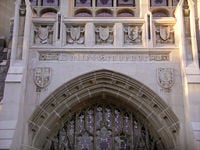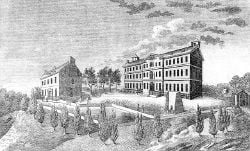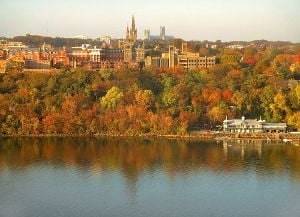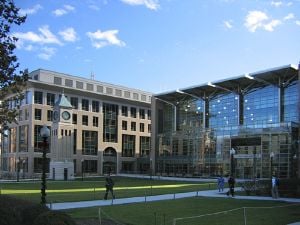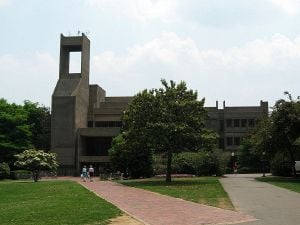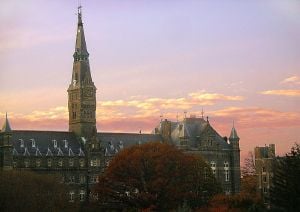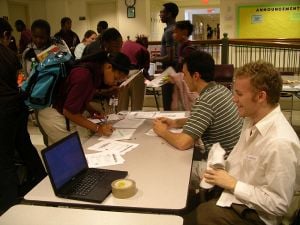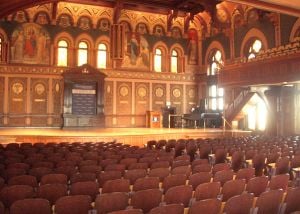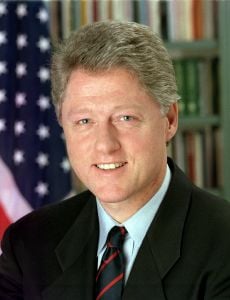Georgetown University
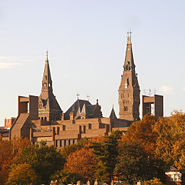
| |
| Motto | Utraque Unum ("Both into One")[1] |
|---|---|
| Established | January 23, 1789 |
| Type | Private |
| Location | Washington, D.C., 20057 USA |
| Website | www.georgetown.edu |
Georgetown University is a private, Jesuit, research university, located in Washington, DC's Georgetown neighborhood. Father John Carroll founded the school in 1789, though its roots extend back to 1634. While the school struggled financially in its early years, Georgetown expanded into a branched university after the U.S. Civil War under the leadership of university president Patrick Francis Healy. Georgetown is both the oldest Roman Catholic and oldest Jesuit university in the United States. Its religious heritage is defining for Georgetown's identity, but has at times been controversial.
Georgetown's three urban campuses feature traditional collegiate architecture and layout, but prize their green spaces and environmental commitment. The main campus is known for Healy Hall, designated a National Historic Landmark. Academically, Georgetown is divided into four undergraduate schools and four graduate schools, with nationally recognized programs and faculty in international relations, law, and medicine.
The student body is noted for its pluralism and political activism, as well as its sizable international contingent. Campus groups include the nation's oldest student dramatic society and the largest student corporation. The Georgetown athletics teams are nicknamed "the Hoyas," made famous by their men's basketball team, which leads the Big East Conference with seven tournament championships. Georgetown's most notable alumni, such as former U.S. President Bill Clinton, served in various levels of government in the United States and abroad.
Mission and reputation
Jesuit settlers from England founded the Province of Maryland in 1634. However, the 1646 defeat of the Royalists in the English Civil War led to stringent laws against Catholic education and the extradition of known Jesuits from the colony. During the greater part of the Maryland colonial period, Jesuits continued to conduct Catholic schools clandestinely.[2] It was not until after the American Revolution in 1776 that long-term plans to establish a permanent Catholic institution for education in America were realized.[3]
Following the revolution, Pope Pius VI appointed John Carroll, a Maryland Jesuit, as the first head of the Catholic Church in America, although the suppression of the Jesuit order was still in effect. Carroll saw the need for education among America's Catholic citizens and accordingly sought to establish a university to meet this need.
History
The founding of Georgetown University took place on two main dates, 1634 and 1789. Until 1851, the school used 1788, the start of construction on the Old South building, as its founding date. In that year a copy-edit in the college catalog began mis-labeling the construction as beginning in 1789. This was discovered in preparation for the centennial celebration in 1889, at which point rather than correct the annual, the date of Georgetown's "foundation" was fixed to the date 1789-01-23.[4]
Founding
Carroll orchestrated the early development of a new university, and on January 23, 1789 obtained the property on Dahlgren Quadrangle was built.[5] Instruction at the school began on November 22, 1791 with future Congressman William Gaston as its first student.[6]
In its early years, Georgetown College suffered from considerable financial strain, relying on private sources of funding and the limited profits from local Jesuit-owned lands.[7] The Maryland Society of Jesus was restored in 1805 and given supervision of the school, which bolstered confidence in the college.[8] The United States Congress issued Georgetown the first federal university charter in 1815, which allowed it to confer degrees. The college's first two graduates were awarded the degree of bachelor of arts two years later in 1817.[9] In 1844, the school received a corporate charter, under the name "The President and Directors of Georgetown College," affording the growing school additional legal rights.[10] In response to the demand for a local option for Catholic students, the Medical School was founded in 1851.
Civil War
The U.S. Civil War greatly affected Georgetown as 1,141 students and alumni enlisted and the Union Army commandeered university buildings. By the time of President Abraham Lincoln's May 1861 visit to campus, 1,400 troops were stationed in temporary quarters there.[11] Due to the number of lives lost, enrollment levels remained low until well after the war was over. Only seven students graduated in 1869, down from over 300 in the prior decade.[12]
At its founding in 1876, the Georgetown College Boat Club, the school's rowing team, adopted blue, used for Union uniforms, and gray, used for Confederate uniforms, as its colors to signify the peaceful unity among students. Subsequently, the school adopted blue and gray as its official colors.[13]
Enrollment did not recover from the war until the presidency of the Patrick Francis Healy (1873–1881). The first acknowledged head of an American university of African descent, Healy is credited with reforming the undergraduate curriculum, lengthening the medical and law programs, and creating the Alumni Association.
Expansion
After the founding of the Law Department in 1870, Healy and his successors sought to bind the professional schools into a university, and focus on higher education. The School of Medicine added a dental school in 1901 and the undergraduate School of Nursing in 1903. Georgetown Preparatory School relocated from campus in 1919 and fully separated from the University in 1927. The School of Foreign Service (SFS) was founded in 1919 by Edmund A. Walsh, to prepare students for leadership in foreign commerce and diplomacy.[14] The School of Business Administration was created out of the SFS in 1957, and in 1999 was renamed the McDonough School of Business in honor of alumnus Robert E. McDonough. These news schools have called for new construction, and since completion of Healy Hall in 1879, Georgetown has added 54 buildings on their main campus.
Besides expansion of the University, Georgetown also aimed to expand their student body. The School of Nursing has admitted female students since its founding, and most of the university was made available on a limited basis by 1952. With the College of Arts and Sciences welcoming its first female students in the 1969–1970 academic year, Georgetown became fully coeducational. Georgetown ended its bicentennial year of 1989 by electing Leo J. O'Donovan as president. He subsequently launched the Third Century Campaign to build the school's endowment. In December 2003, Georgetown completed the campaign, joining only a handful of universities worldwide to raise at least $1 billion for financial aid, academic chair endowment, and new capital projects.
Facilities
Georgetown University has three campuses in Washington, D.C.: the undergraduate campus, the Medical Center, and the Law Center. The undergraduate campus and Medical Center together form the main campus. Georgetown also operates a facility in Doha, Qatar, and villas in Alanya, Turkey, and Fiesole, Italy.[15] In their campus layout, Georgetown's administrators consistently used the traditional quadrangle design.
Main campus
Georgetown University's undergraduate campus and medical school campus are situated on an elevated site above the Potomac River, overlooking northern Virginia. The main gates, known as the Healy Gates, are located at the intersection of 37th and O Streets, NW. The medical school is on a property adjacent to the northwestern part of the undergraduate campus on Reservoir Road, and is integrated with Georgetown University Hospital. Georgetown Visitation, a private Roman Catholic high school, is on land adjoining the main campus. Most buildings employ collegiate Gothic architecture and Georgian brick architecture. Campus green areas include fountains, a cemetery, large clusters of flowers, groves of trees, and open quadrangles. The main campus has traditionally centered on Dahlgren Quadrangle, although Red Square has replaced it as the focus of student life. Healy Hall, built in Flemish Romanesque style from 1877 to 1879, is the architectural gem of Georgetown's campus, and is a National Historic Landmark. Both Healy Hall and the Georgetown University Astronomical Observatory, built in 1844, are listed on the [[National Register of Historic Places. In late 2003, the school completed the Southwest Quadrangle Project, and brought a new 907-bed student dorm, an expansive dining hall, an underground parking facility, and new Jesuit Residence to the campus. The school's first performing arts center, named for Royden B. Davis, was completed in November 2005, while longer-term projects include a self-contained business school campus, construction of a unified sciences center, and expanded athletic facilities.
Law Center campus
The Law Center campus is located in the Capitol Hill neighborhood on New Jersey Avenue, near Union Station. Most second- and third-year students, as well as some first-year students, live off-campus. The "Campus Completion Project," finished in 2005, saw the addition of the Hotung International Building and the Sport and Fitness Center.
Research
Georgetown University is a self described "student-centered research university" considered by the Carnegie Classification of Institutions of Higher Education to have "very high research activity." As of 2007, Georgetown's libraries hold 2,435,298 items in seven buildings, with most in Lauinger Library. Additionally, the Law School campus includes the nation's fifth largest law library.[16] Georgetown faculty conduct research in hundreds of subjects, but have priorities in the fields of religion, ethics, science, public policy, and cancer medicine. In 2006, researchers at Georgetown's Lombardi Comprehensive Cancer Center developed the breakthrough HPV vaccine for cervical cancer.
Facilities abroad
In December 1979, the Marquesa Margaret Rockefeller de Larrain, granddaughter of John D. Rockefeller, gifted the Villa Le Balze to Georgetown University. The Villa is in Fiesole, Italy, on a hill above the city of Florence. The Villa is used year-round for study abroad programs focused on specialized interdisciplinary study of Italian culture and civilization. The main facility for the McGhee Center for Eastern Mediterranean Studies was donated to Georgetown in 1989 by alumnus and former United States Ambassador to Turkey George C. McGhee. The school is in the town of Alanya, Turkey within the Seljuq-era Alanya Castle, on the Mediterranean Sea. The Center operates study-abroad programs each spring semester, concentrating on Turkish language, architectural history, and Islamic studies.[17] In 2002, the Qatar Foundation for Education, Science and Community Development presented the School of Foreign Service with the resources and space to open a facility in the new Education City in Doha, Qatar.[18] SFS-Qatar opened in 2005 as a liberal arts and international affairs undergraduate school for regional students.[19]
Academics
Georgetown University offers undergraduate degrees in 48 majors in the four undergraduate schools, as well as the opportunity for students to design their own individualized courses of study. All majors in the College are open as minors to students in the College, the School of Nursing and Health Studies, and the School of Business. Students in the School of Foreign Service cannot receive minors, but can complete certificates instead. Georgetown offers many opportunities to study abroad, and 58.7 percent of the undergraduate student body spends time at an overseas school.
Master's and doctoral programs are offered through the Graduate School of Arts and Sciences, the Law Center, the School of Medicine, the Public Policy Institute, and the School of Continuing Studies. The McDonough School of Business and the Edmund A. Walsh School of Foreign Service both offer masters programs.
Student life
Almost all undergraduates attend full-timewith 72 percent, living on-campus in several dormitories and apartment complexes. The remainder live off-campus, mostly in the Georgetown, Burleith, and Foxhall neighborhoods. All students in the Medical School live off-campus, most in the surrounding neighborhoods, with some in Dupont Circle and elsewhere through the region.
Student groups
Georgetown University has 172 registered student organizations that cover a variety of interests: student government, club sports, media and publications, performing arts, religion, and volunteer and service. [20] [21] The Georgetown University Student Association is the student government organization for undergraduates. There are also student representatives within the schools, to the Board of Directors, and, since 1996, to the Georgetown Advisory Neighborhood Commission.[22] New Student Orientation is the sponsored student organization responsible for planning and executing the annual pre-orientation and orientation of freshmen and transfer students. Georgetown's Army ROTC unit, the Hoya Battalion, is the oldest military unit native to the District of Columbia.[23]
Georgetown's student organizations include one of the nation's oldest debating clubs, the Philodemic Society, and the oldest running dramatic society, the Mask & Bauble Society. The Georgetown Chimes, founded in 1946, is the University's oldest and only all-male singing group. Other a cappella groups on campus include the coed Phantoms, the coed Superfood, the all-female GraceNotes, the all-female international group Harmony, and the service-focused Georgetown Saxatones. The D.C. A cappella Festival has been held on Georgetown's campus since its inception in 1990. [24]
In addition to student organizations and clubs, Georgetown University is home to the nation’s largest entirely student-owned and -operated corporation, Students of Georgetown, Inc.[25] Known as "The Corp," the business sees gross revenues of roughly $3.3 million a year.[26] Founded in 1972, The Corp operates three coffee shops, two grocery stores, and a DVD rental service. It also runs biannual book sales, box storage, and airport shuttles for students. The Georgetown University Student Investment Fund is one of a few undergraduate-run investment funds in the United States, and hosted CNBC's Jim Cramer to tape Mad Money in September 2006
Media
Georgetown University has several student-run newspapers. The Hoya is the University's oldest newspaper. It has been in print since 1920, and, since 1987, is published twice weekly. The Georgetown Voice, known for its weekly cover stories, is a newsmagazine that split from The Hoya to focus more attention on citywide and national issues.[27] The Georgetown Independent is a monthly "journal of news, commentary and the arts." The Georgetown Academy targets more conservative readers on campus and the Georgetown Federalist, founded in 2006, purports to bring a "conservative and libertarian" viewpoint to campus.[28] The Georgetown Heckler is a humor magazine founded on the Internet in 2003 by Georgetown students, releasing its first print issue in 2007.
The University has a campus-wide television station, GUTV, which began broadcasting in 1999. The station hosts an annual student film festival in April for campus filmmakers. [29] WGTB, Georgetown's radio station, is available as a webcast and on 92.3 FM in certain dormitories. The station was founded in 1946, and broadcast on 90.1 FM from 1960 to 1979, when president Timothy S. Healy gave away the frequency to the University of the District of Columbia because of WGTB's far left political orientation.[30]
Activism
Georgetown University student organizations include a diverse array of groups focused on social justice issues, including organizations run through both Student Affairs and the Center for Social Justice. Oriented against gender violence, Take Back the Night coordinates an annual rally and march to protest against rape and other forms of violence against women. Georgetown Solidarity Committee is a workers' rights organization whose successes include ending use of sweatshops in producing Georgetown-logoed apparel, and garnering pay raises for both university cleaning staff and police. Georgetown has many additional groups representing national, ethnic, and linguistic interests. In 2006, MEChA de Georgetown, which works to improve Chicano recruitment and involvement, brought together a broad coalition of groups as "GU Students United Against Racism" to protest the perceived racism during a paid speaking event by Chris Simcox, leader of the Minutemen Civil Defense Corps.[31] Georgetown's student body is particularly active in politics; groups based on local, national, and international issues are popular, and free speech is generally respected. The reproductive rights organization H*yas for Choice is not officially recognized by the University, prompting the asterisk in "hoyas." [32] While not financially supported by the school (its positions on abortion are in opposition to University policy), the organization is permitted to meet and table in university spaces. The issue contributes to Georgetown's 'red light' status on free speech under the Foundation for Individual Rights in Education rating system.
Greek life
Although Jesuit schools are not obliged to disassociate from Greek systems, Georgetown University does not officially recognize or fund fraternities, sororities, or secret societies among the student body.[33] Despite this, Greek organizations persist on campus.[34] Additionally, Georgetown University students are affiliated, in some cases, with fraternities at other nearby universities and colleges.
Active fraternities at Georgetown include Delta Phi Epsilon, a professional foreign service fraternity; Alpha Kappa Psi, a professional business fraternity; Alpha Phi Omega, a national community service fraternity; Alpha Epsilon Pi; and Sigma Phi Epsilon. Delta Phi Epsilon was founded at Georgetown in 1920, and members of their Alpha Chapter include Jesuits and several deans of the School of Foreign Service.[35] The Delta Phi Epsilon foreign service sorority, founded in 1973, is the only sorority active at Georgetown.[36] Georgetown's chapter of Alpha Epsilon Pi, affiliated with the campus Hillel, was established in 2002.[37] Sigma Phi Epsilon chartered its chapter as a general social fraternity in 2007.[38]
Events
Annual events on campus celebrate Georgetown traditions, culture, alumni, sports, and politics. In late April, Georgetown University celebrates Georgetown Day.[39] Besides the full-day carnival, the day rewards the best professor of the year with the Dorothy Brown Award, as voted by students. Every year since 2002, Traditions Day has focused attention in early November on the two centuries of Georgetown history.
Homecoming coincides with a home football game, and festivities such as tailgating and a formal dance are sponsored by the Alumni Association to draw past graduates back to campus. The largest planned sports related celebration is the first basketball practice of the season. Dubbed Midnight Madness, this event introduces the men's and women's basketball teams shortly after midnight on the first day the teams are allowed by NCAA rules to formally practice together. In 2008, Georgetown will again play host to a first round division of the NCAA Men's Basketball Tournament.
Georgetown University hosts notable speakers each year, largely because of the success of the Georgetown Lecture Fund and the Office of Communications. These are frequently important heads of state who visit Georgetown while in the capital, as well as scholars, authors, U.S. politicians, and religious leaders. The Office of the President hosts numerous symposia on religious topics, such as Nostra Ætate and the Building Bridges Seminar. [40]
Athletics
Georgetown fields 27 varsity teams and 20 club teams.[41] The varsity teams participate in the NCAA's Division I. The school generally competes in the Big East Conference, although the football team competes in the Division I FCS Patriot League, the men's lacrosse team in Eastern College Athletic Conference, and the rowing teams in the Eastern Association of Rowing Colleges. Georgetown University graduates over 90 percent of its student athletes.[42][43] U.S. News and World Report listed Georgetown's athletics program among the 20 best in the nation.[44]
The school's teams are called "Hoyas," a name whose origin is uncertain. Sometime after 1866, students well versed in classical languages invented the mixed Greek and Latin chant of "hoya saxa," translating roughly as "what (or such) rocks." The baseball team was founded 1870, and football in 1874, and the chant likely refers to one of these teams.[45] Shortly after its founding in 1920, students requested that Georgetown's newspaper take the name The Hoya rather than The Hilltopper. By 1928, campus sports writers began to refer to teams as the "Hoyas" rather than as the "Hilltoppers."[46] The name was picked up in the local publications, and became official shortly after. The mascot of Georgetown athletics programs is Jack the Bulldog and the school fight song is There Goes Old Georgetown.
The men's basketball team is particularly noteworthy as it won the NCAA championship in 1984 under coach John Thompson and continues to be a perennial favorite in the NCAA tournament. Besides basketball, Georgetown is nationally successful in rugby, rowing, sailing, lacrosse, and track and field.[47][48][49][50]
Alumni
Georgetown's alumni include numerous public figures, of whom many have served in the United States Senate and House of Representatives.[51] Besides numerous members of the senior diplomatic corps, ten heads of state are alumni, including former U.S. president Bill Clinton.[52] In the legal profession, alumni include a current Associate Justice of the U.S. Supreme Court, Antonin Scalia, and former Chief Justice of the Supreme Court Edward Douglass White.[53][54] Of schools with less than 15,000 graduates annually, Georgetown produces more Peace Corps volunteers than any other private university. Georgetown graduates have served at the head of diverse institutions, both in the public and private sector, and have headed military organizations on both the national and international level.[55]
Notes
- ↑ From the Epistle to the Ephesians 2:14. See official explanation. Other translations available.
- ↑ William Coleman Nevils. Miniatures of Georgetown: Tercentennial Causeries. (Washington, DC: Georgetown University Press, 1934)
- ↑ E.I. Devitt [1] Georgetown University Catholic Encyclopedia 1909. Robert Appleton Company. accessdate 2007-07-10
- ↑ Paul R. O'Neill and Paul K. Williams. Georgetown University. (Arcadia, 2003. ISBN 0738515094)
- ↑ The first University building accessdate 2007-02-26 About Georgetown
- ↑ William Gaston and Georgetown Bicentennial Exhibit Georgetown University. November 11, 2000. accessdate 2007-07-03
- ↑ O'Neill and Williams
- ↑ Robert Emmett Curran Georgetown: A Brief History Undergraduate Bulletin Georgetown University. July 7, 2007 accessdate 2007-08-27
- ↑ The Federal Charter About Georgetown accessdate 2007-03-06
- ↑ O'Neill and Williams, 7
- ↑ Ibid., 36
- ↑ Ibid., 39
- ↑ [2]About Georgetown The Civil War. accessdate 2007-04-26
- ↑ [3] About Georgetown The School of Foreign Service accessdate 2007-04-26
- ↑ John Fedynsky and Taylor Kushner [4] OIP provides study abroad options. September 25, 2000. accessdate 2007-07-08 The Georgetown Independent
- ↑ Library Resident Program. www.ll.georgetown.edu. 2007. accessdate 2007-07-09
- ↑ Courses Offered in Spring 2008 Georgetown University. McGhee Center for Eastern Mediterranean Studies. June 7, 2007. accessdate 2007-07-26
- ↑ Robert Heberle |title= SFS to Establish Qatar Campus. The Hoya May 20, 2005. accessdate 2007-08-04
- ↑ Studying International AffairsGeorgetown University School of Foreign Service in Qatar accessdate 2007-07-26
- ↑ Extracurriculars America's Best Colleges 2008 US News & World Report 2007
- ↑ Student Organizations accessdate 2007-04-19. explore.georgetown.edu.
- ↑ Adam Giblin Support Your Neighborhood, Vote in D.C.. The Hoya October 1, 2002. 2007-07-03
- ↑ HOYA Battalion and the Washington Consortium The HOYA Battalion. 2005. accessdate 2007-03-02
- ↑ Michael Bayer A capella abounds at DCAF . The Georgetown Independent. November 5, 2003. accessdate 2007-08-19
- ↑ History of The Corp 2005. accessdate 2007-03-10. The Corp
- ↑ Emily Solis-CohenCorp Surplus Falls Far Short of Previous Year’s. January 19, 2007 The Hoya accessdate 2007-07-09
- ↑ Josh Zumbrun How Georgetown Found a Different Voice. The Hoya accessdate 2007-07-03. January 14, 2005
- ↑ Stephen Santulli The Right's Fight to Write. The Hoya November 7, 2006. accessdate 2007-05-02
- ↑ Alicia Chen Giving Your Vision A Voice The Hoya March 17, 2006. accessdate= 2007-08-19
- ↑ Liam Dillon Finding a Place for Campus Radio. www.georgetownvoice.com. October 17, 2002 accessdate 2007-08-19
- ↑ Keenan Steiner Students protest ‘Minutemen’ leader The Georgetown Voice November 2, 2006. accessdate 2007-03-04
- ↑ Anne K. Walters [5] Gimme an 'O'! The Chronicle of Higher Education May 12, 2006. archivedate 2007-08-25
- ↑ Washington, Vanessa, "Weakly Greek", The Hoya, April 21, 2006. Retrieved 2007-07-19.
- ↑ Singh, Suma, "Greek Life: Alive and Well At Georgetown", The Hoya, September 19, 2000. Retrieved 2007-03-10.
- ↑ Frequently Asked Questions. Delta Phi Epsilon (November 22, 2006). Retrieved 2007-08-16.
- ↑ Sorority. Delta Phi Epsilon (April 16, 2007). Retrieved 2007-08-16.
- ↑ Glick, Michael, "AEPi Fosters Greek and Jewish Life", The Hoya, October 29, 2002. Retrieved 2007-04-27.
- ↑ Haviland, Erica, "SigEp Receives National Charter", The Hoya, April 27, 2007. Retrieved 2007-04-27.
- ↑ [http://www3.georgetown.edu/admin/provost/GeorgetownDay/about.html About Georgetown Day. accessdate 2007-07-27
- ↑ Nostra Ætate Office of the President. Georgetown University 2007 accessdate 2007-04-09
- ↑ Teams. Club Sports. Georgetown University (April 30, 2007). Retrieved 2007-07-17.
- ↑ Freshman-Cohort Graduation Rates (PDF). 2006 NCAA Report on the Federal Graduation-Rates Data (2000). Retrieved 2007-07-26.
- ↑ Park, Ji-Hye, "Athlete Graduation Rates Outpace National Average in NCAA Study", The Hoya, November 14, 2006. Retrieved 2007-07-26.
- ↑ Error on call to template:cite web: Parameters url and title must be specifiedWitkin, Gordon and Jodi Schneider (March 10, 2002). . U.S. News and World Report.
- ↑ O'Neill, Paul R. and Paul K. Williams (2003). Georgetown University. Arcadia, 54, 62. ISBN 0-7385-1509-4.
- ↑ What's A Hoya?. HoyaSaxa.com (August 17, 2005). Retrieved 2007-04-30.
- ↑ Mendoza, Moises, "Experience, Leadership and Vision Propel Hoya Crew to National Prominence", The Hoya, May 20, 2005. Retrieved 2007-07-19.
- ↑ Wood, Julie, "Coed Sailing Captures National Championship", The Hoya, August 24, 2001. Retrieved 2007-07-03.
- ↑ Georgetown Men's Lacrosse Moves Up to No. 4 in National Rankings. Georgetown University Official Athletic Site (April 24, 2007). Retrieved 2007-04-26.
- ↑ Jammet, Nicolas, "Georgetown's Track Program Quietly Dominates", The Hoya, November 23, 2004. Retrieved 2007-07-26.
- ↑ Well-known Georgetown Alumni Georgetown University. Georgetown Facts. February 1, 2006. accessdate= 2007-07-18
- ↑ Georgetown University alumni About Georgetown 2007. accessdate 2007-07-24
- ↑ About The Hoya. The Hoya accessdate 2007-08-27
- ↑ Edward Douglass White. www.supremecourthistory.org June 16, 2004. accessdate 2007-07-18
- ↑ Jon Shoup-Mendizabal Glory Days. The Hoya January 23, 2004. accessdate 2007-08-27
ReferencesISBN links support NWE through referral fees
- Carrier, Thomas. Historic Georgetown: A Walking Tour. Arcadia Publishing, 1999. ISBN 0738502391
- Curran, Robert. The Bicentennial History of Georgetown University: From Academy to University 1789-1889. Georgetown University Press, 1993. ISBN 0878404856
- McFadden, William C. Georgetown at Two Hundred: Faculty Reflections on the University's Future. Georgetown University Press, 1990. ISBN 978-0878405039
- Nevils, William C. Miniatures of Georgetown: Tercentennial Causeries. 1–25. Washington, DC: Georgetown University Press, 1934.
- O'Neill, Paul. Georgetown University. Arcadia Publishing, 2003. ISBN 0738515094
- Richmond, Derek, et. al. Georgetown University DC 2007. College Prowler, 2006. ISBN 1427400660
- The First 125 Years: An Illustrated History of the Georgetown University Law Center. Georgetown University Law Center, 1995. ISBN 096491820X
Gallery
External links
All links retrieved May 21, 2024.
Credits
New World Encyclopedia writers and editors rewrote and completed the Wikipedia article in accordance with New World Encyclopedia standards. This article abides by terms of the Creative Commons CC-by-sa 3.0 License (CC-by-sa), which may be used and disseminated with proper attribution. Credit is due under the terms of this license that can reference both the New World Encyclopedia contributors and the selfless volunteer contributors of the Wikimedia Foundation. To cite this article click here for a list of acceptable citing formats.The history of earlier contributions by wikipedians is accessible to researchers here:
The history of this article since it was imported to New World Encyclopedia:
Note: Some restrictions may apply to use of individual images which are separately licensed.
